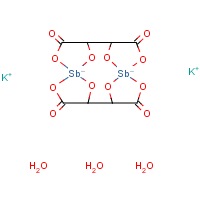Antimony potassium tartrate
Agent Name
Antimony potassium tartrate
CAS Number
28300-74-5
Formula
C8-H4-O12-Sb2.3H2-O.2K
Major Category
Metals

Synonyms
Antimonate (2-), bis(mu-(2,3-dihydroxybutanedioato(4-)-O1,O2,O3,O4))di-, dipotassium, trihydrate, stereoisomer; Antimonate(2)-, bis(mu-tartrato(4-))di-, dipotassium, trihydrate; Antimonate(2-), bis(mu-(2,3-dihydroxybutanedioato(4-)-O(sup 1),O(sup 2):O(sup 3),O(sup 4)))-di-, dipotassium, trihydrate, stereoisomer; Antimonyl potassium tartrate; Dipotassium bis(mu-(L-(+)-tartrato(4-)))diantimonate(2-) trihydrate; Emetique [French]; Potassium antimony tartrate; Potassium antimonyl d-tartrate; Potassium antimonyl tartrate; Potassium antimonyltartrate; Tartar emetic; Tartaric acid, antimony potassium salt; Tartarized antimony; Tartox; Tartrate antimonio-potassique [French]; Tartrated antimony; [ChemIDplus] UN1551
Category
Metalloid Compounds (Antimony)
Description
Transparent odorless solid; Efflorescing on exposure to air; Or white solid; [Hawley] Crystalline solid; [MSDSonline]
Sources/Uses
Used as mordant in the textile and leather industries, a pesticide (snails and insects), and a medication (schistosomicides and veterinary parasiticides) [HSDB]
Comments
When used as an IV medication, side effects included nervous complaints, cardiac arrhythmias, liver and kidney injury, and death; The minimum fatal dose for humans is 130 mg with a report of a survival after 15,000 mg; May produce pustular eruptions if applied to skin for long periods; Oral LD50 (mouse) = 600 mg/kg; [HSDB] A skin, eye, and respiratory tract irritant; [CAMEO] An irritant; Effects in high-dose animal studies include acute renal failure and acute and hepatocellular necrosis; [MSDSonline] See "Antimony" and linked occupational diseases.
Biomedical References
Exposure Assessment
TLV (ACGIH)
0.5 mg/m3, as Sb
PEL (OSHA)
0.5 mg/m3, as Sb
IDLH (NIOSH)
50 mg/m3, as Sb
Adverse Effects
Hepatotoxin
Hepatoxic (a) from occupational exposure (secondary effect) or (b) in animal studies or in humans after ingestion
Nephrotoxin
Yes
IARC Carcinogen
Probable (2a)
Diseases, Processes, and Activities Linked to This Agent
Processes
Industrial Processes with risk of exposure: